Objective: To study the short-term risk of suicide after nonfatal deliberate self-harm and its association with coexisting mental disorders and with the method of self-harm used.
Method: We used linked Swedish national registers to design a cohort study with 34,219 individuals (59% females) who were admitted to hospital in 2000-2005 after deliberate self-harm (ICD-10-defined). They were followed for 3-9 years. The studied outcome was completed suicide; Cox regression models yielded hazard ratios (HRs) for suicide risk. Temporal patterns were plotted with Kaplan-Meier survival curves, calculated separately for each mental disorder and for the method used at the previous self-harm event.
Results: 1,182 subjects committed suicide during follow-up (670 males and 512 females). Coexisting bipolar disorder (in males, adjusted HR = 6.3; 95% confidence interval [CI], 3.8-10.3; in females, adjusted HR = 5.8; 95% CI, 3.4-9.7) and nonorganic psychotic disorder (in males, adjusted HR = 5.1; 95% CI, 3.5-7.4; in females, adjusted HR = 4.6; 95% CI, 2.8-7.7) implied the highest risk of suicide after previous self-harm. Hanging as index self-harm method was a strong predictor of later suicide in both males (adjusted HR = 5.3; 95% CI, 4.0-7.0) and females (adjusted HR = 4.5; 95% CI, 2.5-8.1). Of those with bipolar disorder who used a method other than poisoning at the index event, 20.4% had already committed suicide after 3-9 years.
Conclusion: Individuals with severe mental disorders (affective and psychotic disorders) have a poor prognosis in the first years after hospital admission due to self-harm. The risk of subsequent suicide is higher after attempts by hanging and other self-injury methods (vs self-poisoning). Aftercare for those with a self-harm episode should focus on treatment of the mental disorder present at the time of the episode.
This work may not be copied, distributed, displayed, published, reproduced, transmitted, modified, posted, sold, licensed, or used for commercial purposes.
By downloading this file, you are agreeing to the publisher’s Terms & Conditions.
Suicide Risk After Nonfatal Self-Harm:
A National Cohort Study, 2000–2008
ABSTRACT
Objective: To study the short-term risk of suicide after nonfatal deliberate self-harm and its association with coexisting mental disorders and with the method of self-harm used.
Method: We used linked Swedish national registers to design a cohort study with 34,219 individuals (59% females) who were admitted to hospital in 2000–2005 after deliberate self-harm (ICD-10–defined). They were followed for 3–9 years. The studied outcome was completed suicide; Cox regression models yielded hazard ratios (HRs) for suicide risk. Temporal patterns were plotted with Kaplan-Meier survival curves, calculated separately for each mental disorder and for the method used at the previous self-harm event.
Results: 1,182 subjects committed suicide during follow-up (670 males and 512 females). Coexisting bipolar disorder (in males, adjusted HR = 6.3; 95% confidence interval [CI], 3.8–10.3; in females, adjusted HR = 5.8; 95% CI, 3.4–9.7) and nonorganic psychotic disorder (in males, adjusted HR = 5.1; 95% CI, 3.5–7.4; in females, adjusted HR = 4.6; 95% CI, 2.8–7.7) implied the highest risk of suicide after previous self-harm. Hanging as index self-harm method was a strong predictor of later suicide in both males (adjusted HR = 5.3; 95% CI, 4.0–7.0) and females (adjusted HR = 4.5; 95% CI, 2.5–8.1). Of those with bipolar disorder who used a method other than poisoning at the index event, 20.4% had already committed suicide after 3–9 years.
Conclusion: Individuals with severe mental disorders (affective and psychotic disorders) have a poor prognosis in the first years after hospital admission due to self-harm. The risk of subsequent suicide is higher after attempts by hanging and other self-injury methods (vs self-poisoning). Aftercare for those with a self-harm episode should focus on treatment of the mental disorder present at the time of the episode.
J Clin Psychiatry
dx.doi.org/10.4088/JCP.14m09453
© Copyright 2015 Physicians Postgraduate Press, Inc.
aDepartment of Clinical Neuroscience, Centre for Psychiatry Research, and bDepartment of Medical Epidemiology and Biostatistics, Karolinska Institute, Stockholm, Sweden
*Corresponding author: Axel Haglund, MD, Department of Clinical Neuroscience, Centre for Psychiatry Research, Karolinska Institute, Vårdvägen 1, 112 81 Stockholm, Sweden ([email protected]).
Despite the development of psychiatric care and efforts at prevention, high suicide rates are still a matter of great concern around the world. One prioritized goal for research in suicide prevention should be to enable better detection of risk, especially imminent or near-term risk.1 Previous nonfatal deliberate self-harm is a known predictor of suicide,2,3 and 1 in 25 patients presenting to the hospital for self-harm will commit suicide within the next 5 years, according to a recent review.4 The risk for suicide is high in the short term, but also if the self-harm act took place in the remote past.5 Further, studies of the long-term prognosis after deliberate self-harm have shown that the risk is associated with coexisting mental disorders.6,7 The prognosis is also associated with the method of the self-harm act,8,9 suicidal intent, male gender, and social factors.10
Long-term studies of suicide risk after nonfatal deliberate self-harm are of relevance to estimate the true risk over a lifetime perspective. Estimates based on short follow-up periods may yield an exaggerated risk, as the risk is higher during the first years after self-harm. The long-term prognosis of patients admitted after self-harm, however, is neither equally valid in the clinical suicide risk assessment nor relevant to the understanding of prevention of suicide in contemporary psychiatric care. A timeframe of months or a few years is also more relevant for the clinical suicide risk assessment, which favors a shorter interval. The diagnostic routines have shifted during the decades, with an effect of the multiaxial diagnostic model, which today yields more diagnostic comorbidity than previous models. However, the prevalence of severe mental disorders seems to be unchanged, while psychiatric treatment is now more easily accessible.11 In many countries, the organization of the mental health care system has undergone vast changes during recent decades, with a stronger emphasis on outpatient care. During the same time interval, from the 1980s to the present, significant decreases in the suicide rates of the general population have been recognized in several countries, possibly associated with the more frequent use of antidepressants.12
Therefore, large studies of recent cohorts are needed so that we may accurately relate suicide risk to psychiatric diagnosis and the different methods of self-harm.
Our aim was to study the risk of suicide after nonfatal self-harm, with a focus on risk during the first few years after the act. The hypotheses were that the risk would be greater in those with coexisting severe psychiatric disorder and if methods other than poisoning had been used.
METHOD
Sources of Data
We conducted a population-based nationwide cohort study using data from 4 Swedish longitudinal population registers. The registers were linked through the personal identification number, a unique identifier assigned to every individual that resides in Sweden on a permanent basis.13 Ethical approval for this study was obtained from the Stockholm Regional Ethics Committee (Protocol 2009/5:10).
The National Patient Register (held by the National Board of Health and Welfare) covers all inpatient health care, including public as well as private institutions. The register has complete national coverage for all inpatient admissions from 1987. Each record contains admission date, discharge date, and discharge diagnostic codes for diseases and injuries, including deliberate self-harm (both intentional self-harm and self-harm with undetermined intent; method used) according to the International Classification of Diseases (ICD)-8, -9, and –10.
The Cause of Death Register (National Board of Health and Welfare) includes all deaths among residents of Sweden, including deaths occurring abroad. The coverage of the register is over 99%. Each record contains the date of death and diagnostic codes for causes of death, including definite suicide and death caused by self-harm with undetermined intent, in accordance with ICD-6, -7, -8, -9, and –10.14
The Total Population Register (Statistics Sweden) contains information about gender, birth date, region of birth, emigration, immigration, and relationships (eg, parents of index persons). The Education Register (Statistics Sweden) contains information on Swedish residents’ highest education level.
Study Cohort
We included all Swedish residents aged 10 or older who were hospitalized in Sweden due to deliberate self-harm during 2000 through 2005 (N = 40,788). We chose to use the term deliberate self-harm in this study, rather than suicide attempt, since it corresponds with the ICD-10 definitions used. The ICD-10 definitions do not address the question of suicidal intent behind the act, only the intent to harm or injure. In studies using register data based on ICD-10 codes, it is not possible to distinguish nonsuicidal but intentional self-harm from self-harm with suicidal intent. Deliberate self-harm was defined as an act of intentional self-harm
or self-harm with undetermined intent (ICD-10 codes X60–84 and Y10–34), as registered in the National Patient Register. If an individual had more than 1 admission for deliberate self-harm during the inclusion period, the first admission was used as the index event. Those with hospitalization for deliberate self-harm within 15 years before the inclusion period were excluded (n = 6,206), to reduce confounding effects or bias due to earlier serious suicide attempts. Further, we excluded patients who died during the index episode if this episode was in somatic care, implicating the index attempt as the cause of the death (n = 363); this served to minimize the risk of classifying completed suicides as nonfatal index events.
The final cohort thus consisted of 34,219 individuals (males: n = 13,879, mean age = 40.5 years, SD = 19.2; females: n = 20,340, mean age = 36.0 years, SD = 20.0). Subjects were followed from inclusion to suicide or death by event with undetermined intent (ICD-10 codes X60–84 and Y10–34), death due to causes other than suicide, first emigration, or end of follow-up (December 31, 2008). The total follow-up time was thus 3–9 years (mean = 5.3, SD = 2.1; median = 5.3).
Variables and Statistical Analyses
The outcome variable was suicide during the entire follow-up. When defining the suicide category, we included both certain suicide and death by event with undetermined intent, since exclusion of the latter might lead to underestimated suicide rates.8,15–17 Three sets of explanatory variables were studied: (1) mental disorder at baseline, (2) method used at the index event, and (3) combinations of mental disorder and method.
Mental disorder at baseline. The psychiatric diagnostic categories were substance use disorder (codes F10–19, ICD-10), nonorganic psychotic disorder (F20–29), bipolar disorder (F30–31), moderate to severe depression (F32.1–32.3, F32.8, F33.1–33.3), other affective disorder (F32.0, F32.9, F33.0, F33.4, F33.8–33.9, F34.0–34.1, F34.8–34.9, F38.0–38.1, F38.8, F39.9), anxiety disorder (F40–48), personality disorder (F60, F61.9), and other mental disorder (remaining diagnoses within the ICD-10 chapter on mental disorder).
Mental disorder at baseline was defined as having received 1 of the psychiatric diagnoses (principal or secondary) in inpatient care during the index episode or during an episode beginning up to 1 week after the inclusion date. If a subject had received a psychiatric diagnosis during more than 1 episode within the inclusion period, the last episode was chosen, to maximize the probability of a valid diagnosis. Further, if an individual had received more than 1 psychiatric diagnosis during an episode, the principal diagnosis was chosen over the first secondary, the first secondary over the second secondary, and so on.
We performed an additional analysis of comorbidity between substance use disorder and affective disorders. For this purpose, we created a new diagnostic category including those who had a substance use disorder comorbid with affective disorder (bipolar disorder, moderate to severe depression, or other affective disorder) at baseline. In this new diagnostic category, the affective disorders were defined as in the previous 2 paragraphs, and substance use disorder was allowed in any diagnostic position and during any episode within the baseline period (up to 1 week after the inclusion date).
Those who had received a psychiatric diagnosis during hospitalization beginning after 1 week but within 1 year after the index event were excluded (n = 6,779), since our aim was to study diagnoses apparent at the time of the index self-harm episode.
Those who had not received a psychiatric diagnosis (F00–99) in inpatient care during an episode before the index event or up to 1 year after were assigned to a reference category (n = 11,558), to be used in the regression models comparing mental disorders. The individuals in this category had mostly been treated only in somatic inpatient care. Probable reasons for not receiving a psychiatric inpatient diagnosis are that the individuals may have had less apparent, milder, or subclinical states of mental disorder and that they never were subjected to psychiatric consultation. The reference category was thus defined to identify a group of subjects who had generally less pronounced symptoms of mental disorder and were expected to have a lower suicide rate than those in the studied diagnostic categories. The latter assumption was confirmed by preliminary analyses, which showed that suicide mortality was substantially lower in the reference category than in the studied diagnostic categories.
Method used at the index event. ICD-10 codes provided information on the method used for each index self-harm event, categorized as poisoning; gassing; hanging, strangulation, or suffocation; drowning; using a firearm or explosive; cutting or piercing; jumping from a height; and other method. The methods were analyzed individually and also divided into self-poisoning (poisoning) and self-injury (remaining methods). This division of methods is in line with several recent studies3,18–20 and is motivated by previous findings that subsequent risk of suicide is lower after self-poisoning than after self-harm by other methods.8 Self-poisoning was chosen as the reference category.
Combinations of mental disorder and method. For the comparison of combinations of mental disorder and method, the methods were dichotomized as self-poisoning and self-injury. The category of self-injury was then combined with each of the diagnostic categories: substance use disorder, nonorganic psychotic disorder, bipolar disorder, and severe depression. Thus, the explanatory variables in this comparison were substance use disorder and self-injury, nonorganic psychotic disorder and self-injury, bipolar disorder and self-injury, and moderate to severe depression and self-injury. The same reference category was chosen as in the comparison of mental disorders (n = 11,558), with or without self-injury.
For each set of explanatory variables, multiple Cox regression models were used to calculate hazard ratios (HRs) with 95% confidence intervals (95% CI) for suicide during follow-up. The potential confounders age, origin of birth (born in Sweden or not), and parents’ highest education level (7-point ordinal scale from not having completed compulsory school to postgraduate education) were covariates in the adjusted analyses. For mental disorders, temporal patterns were plotted with cumulative survival curves for suicide, calculated separately for each illness. All analyses were stratified by gender. SPSS for Windows (Version 22.0; IBM Corp) was used for the analyses.
RESULTS
In the total cohort (N = 34,219), 1,182 suicides occurred (670 males and 512 females), of whom 75% had used a self-poisoning method and the remaining had used different forms of self-injury at the index event. In a subcohort (n = 27,440) consisting of the studied diagnostic groups and a reference category, a total of 914 suicides occurred (3.3%). The differences in risk of suicide between disorders were similar in males and females (Figure 1).
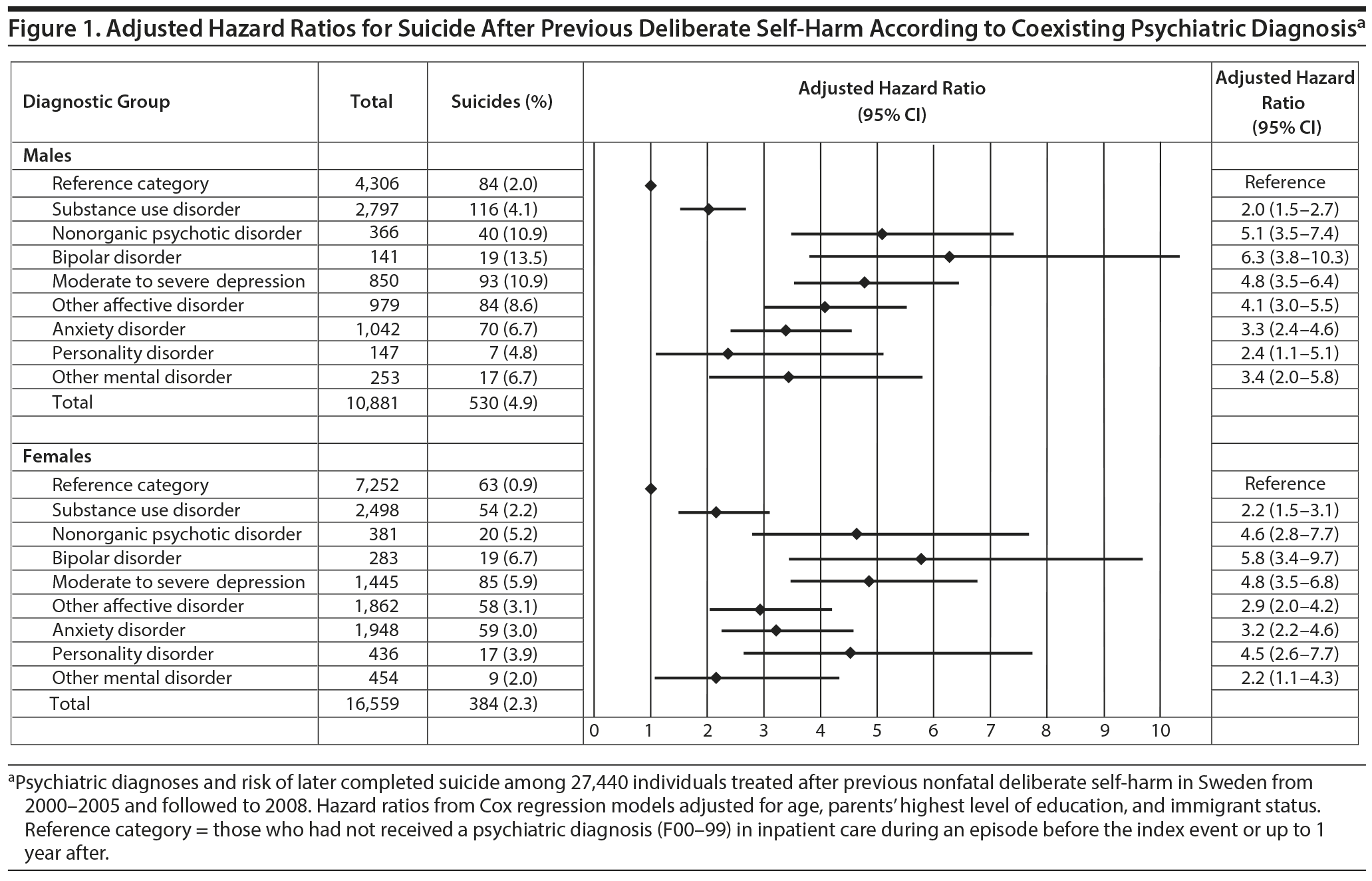
The survival curves (Figure 2) show that individuals with bipolar disorder followed by those with nonorganic psychotic disorder and those with moderate to severe depression had the highest rates of suicide. The proportion of suicide in the reference category was 2.0% in males and 0.9% in females; this was lower than in any studied diagnostic category (Figure 1).
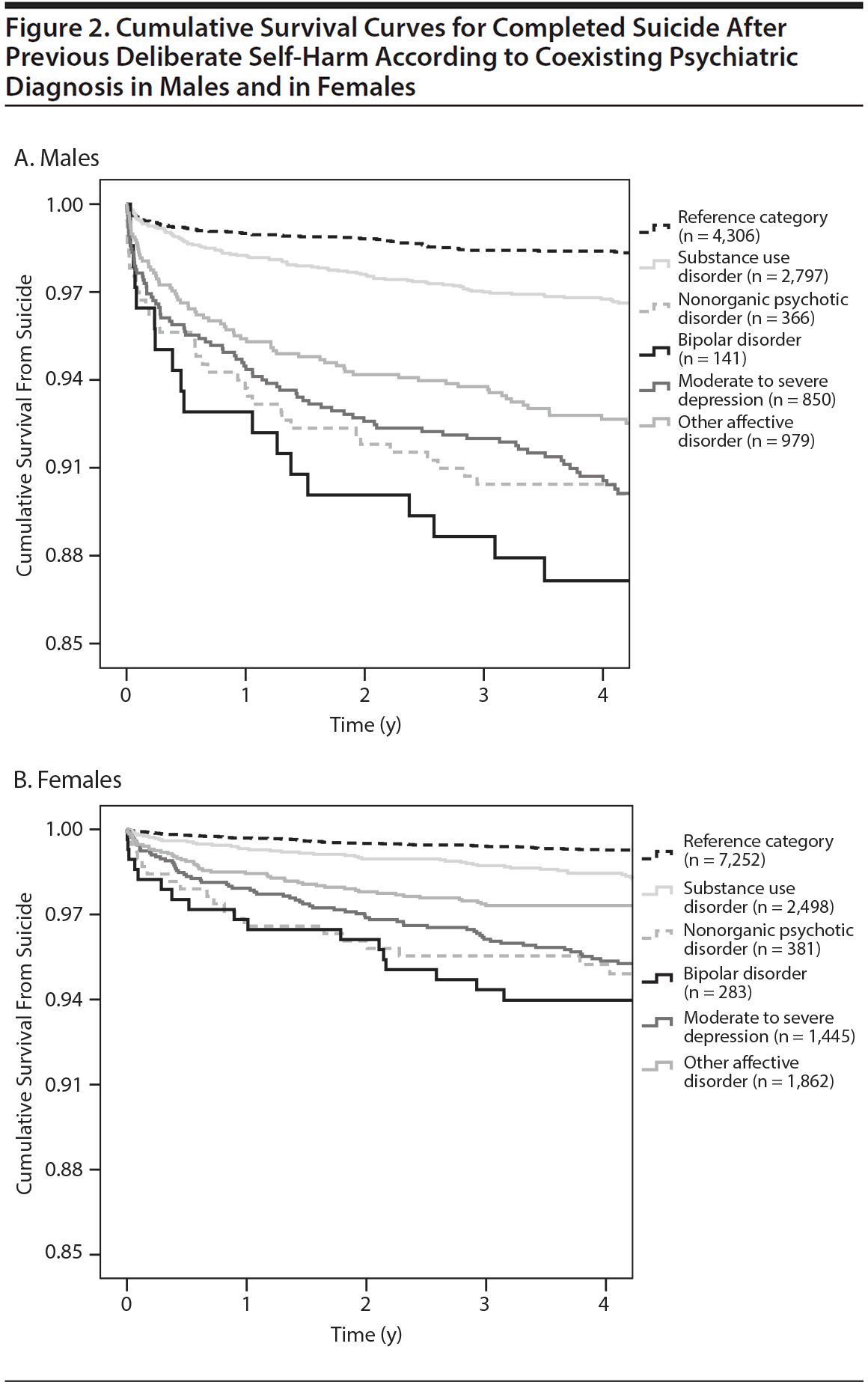
In the adjusted analyses of comorbidity, there were 30 suicides among males with substance use disorder coexisting with any affective disorder (n = 287; HR = 4.6; 95% CI, 3.0–7.0). Among females, there were 12 suicides in this category (n = 348; HR = 2.8; 95% CI, 1.5–5.3).
Concerning the method of the previous deliberate self-harm, hanging implied the highest risk in both males and females (Figure 3). Several methods (hanging, drowning, using firearms, and jumping from heights) differed significantly from poisoning in males, females, or both. Self-harm by cutting differed significantly from poisoning in both genders. Self-harm by hanging or suffocation differed significantly from self-harm by poisoning, gassing, cutting, and jumping from heights in males. Self-harm by hanging differed significantly from poisoning and cutting in females. Of the suicides classified as undetermined intent (n = 207), 87.4% had used self-poisoning; the corresponding figure among the suicides in which intent was certain (n = 975) was 72.8% (P < .001). The pattern for the index attempts was reversed: the proportion of self-poisoning for those with undetermined intent (n = 3,996) was 62.0% and for those classified as deliberate self-harm (n = 23,444) was 87.2% (P < .001).
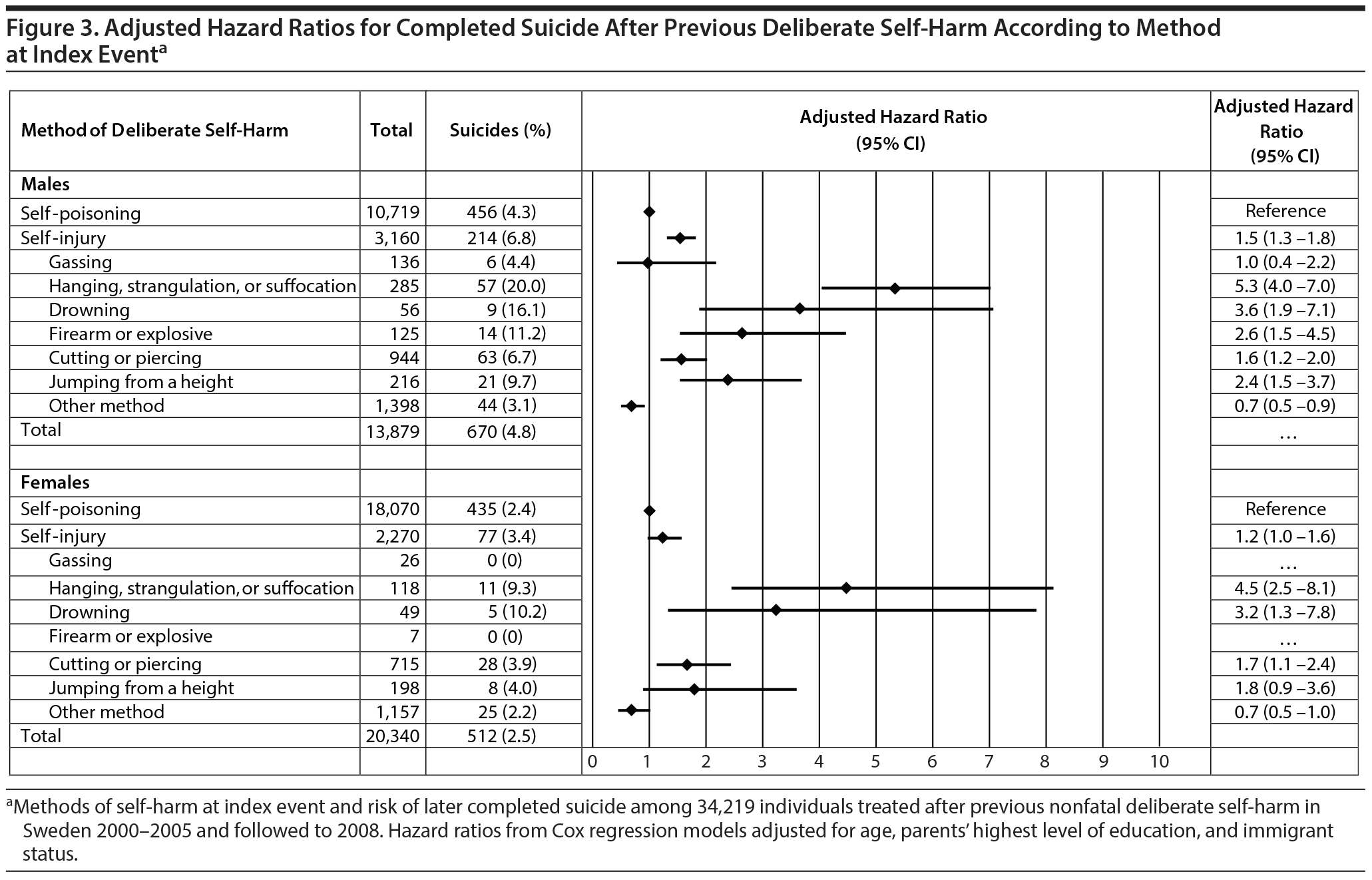
Combining information about method of deliberate self-harm and psychiatric diagnosis resulted in increased hazard ratios for subsequent suicide. Among males, those with nonorganic psychotic disorder who used self-injury methods had an adjusted HR of 10.8 (7.1–16.5), and those with bipolar disorder who used self-injury methods had an adjusted HR of 12.9 (5.9–28.0) (Table 1). For females, bipolar disorder in combination with self-injury method resulted in the highest risk, with an adjusted HR of 15.8 (4.9–51.1). Altogether, we found that 20.4% of all males and females with bipolar disorder who used a self-injury method at index event later committed suicide (Figure 4). For patients with nonorganic psychosis using self-injury method, 15.6% died by suicide, and for those with moderate to severe depression using self-injury method, 13.9% died by suicide during follow-up.
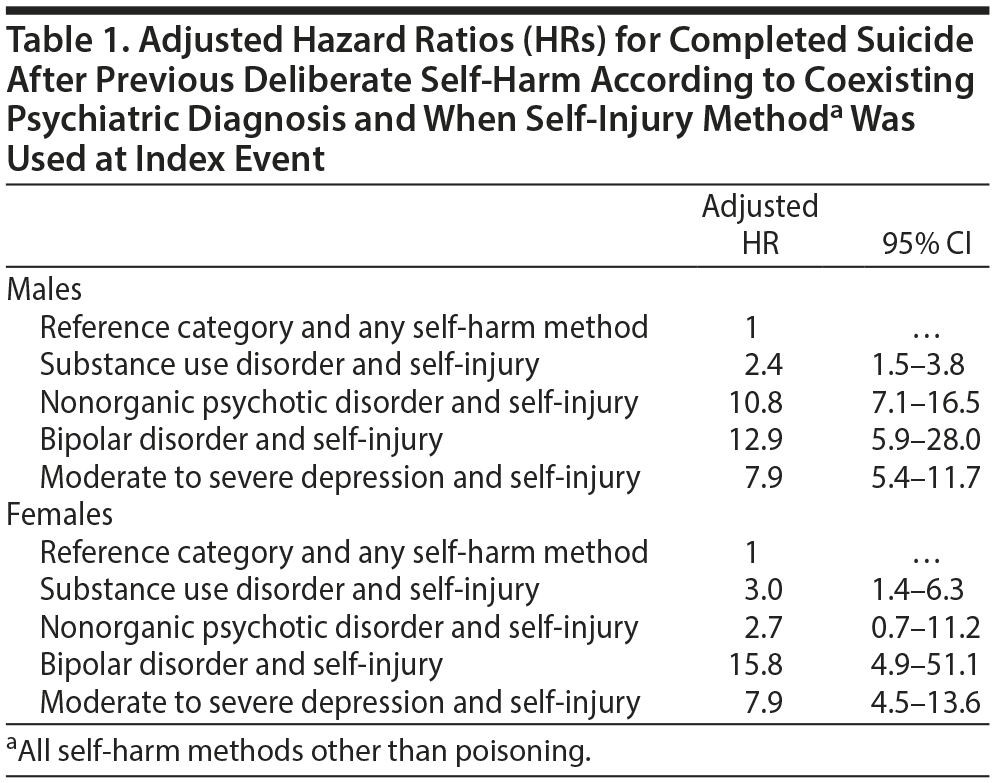
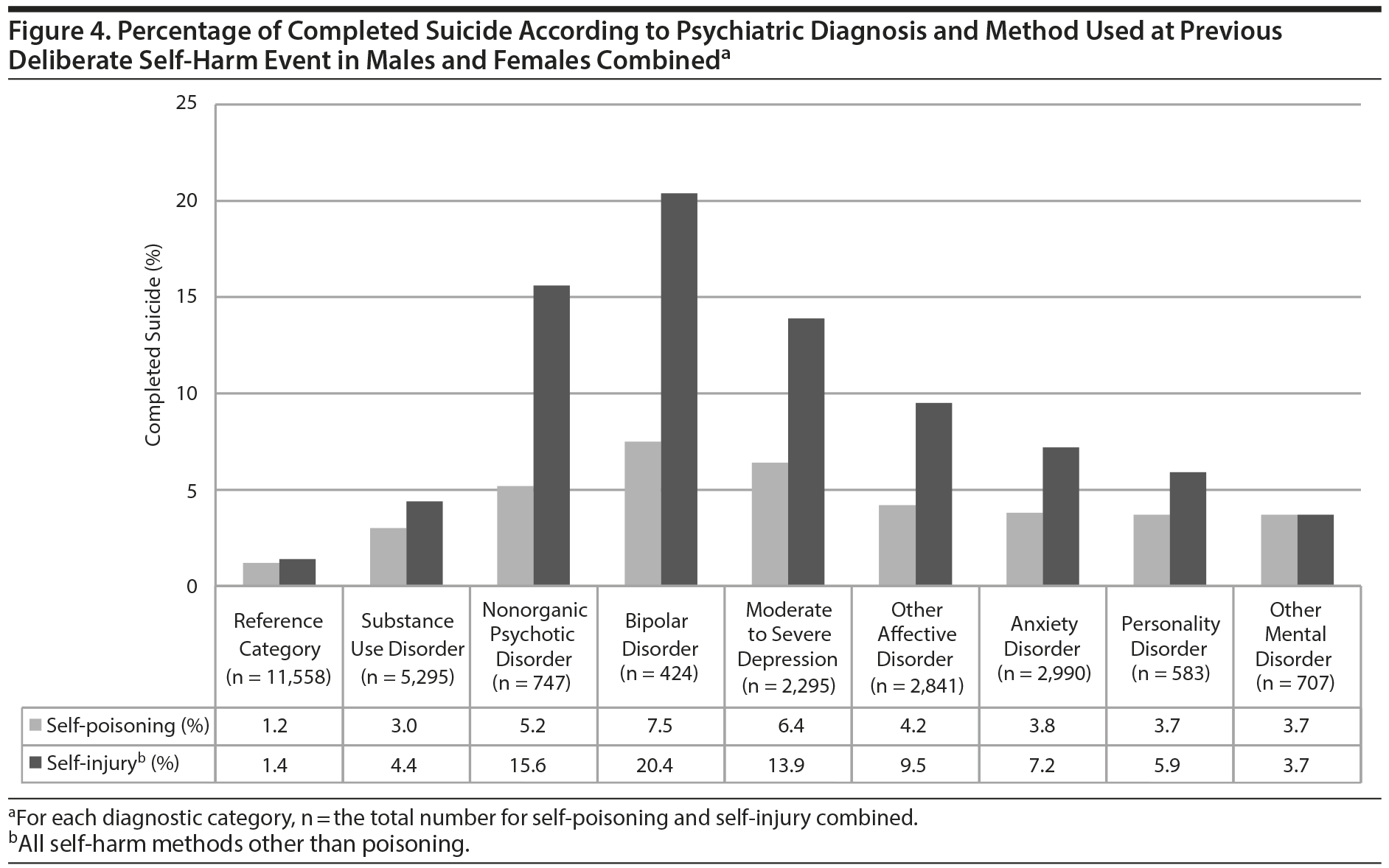
DISCUSSION
The results from this study of suicide after nonfatal deliberate self-harm show that risk patterns are similar to those shown in studies from earlier decades.6,8 Even though psychiatric treatment after nonfatal deliberate self-harm may have improved,21 the prognosis is still poor with coexisting severe mental disorder, with a particularly pronounced risk of completed suicide during the first years after nonfatal deliberate self-harm. As expected, the temporal patterns in this study based on diagnoses from admitted patients resemble that for suicide after discharge from psychiatric hospitals in general, shown in several earlier studies.22,23
Also in line with studies of earlier cohorts,8 the risk of subsequent suicide was especially high after an index event using hanging or another self-injury method.
In a previous study of a cohort from the 1970s and 1980s,6 a large proportion of subjects had no inpatient diagnosis of mental disorder within 1 year after baseline. This had changed by the time of the present study (2000–2005), with only 28% (11,558 of 40,788) of the total cohort of self-harming individuals not having a psychiatric inpatient diagnosis at baseline or within 1 year after. This difference may be partly explained by a shift toward identification of less severe states of mental disorders.24 Interestingly, the patterns are similar in this study compared to previous studies, despite changes in diagnostic routines and treatment strategies over the decades. Bipolar disorder is associated with the highest risk for suicide in the first years after self-harm in both males and females, with the association even more obvious in females than in males during the period of observation. Bipolar disorder is a mental disorder with high risk for suicide also among patients in general.25–27 Lethal and aggressive self-harm events are common among bipolar patients, particularly among males.28 In a Danish population study, 5% of women and 8% of men with bipolar disorder committed suicide in a long-term follow-up after first psychiatric contact.7 A high suicide risk was found in moderate to severe depression and a slightly lower one was found in other affective disorder, also shortly after the index event. The implication is that any type of depression needs to be evaluated as a strong addition to the risk of suicide after nonfatal deliberate self-harm.
Schizophrenia and other nonorganic psychotic disorders also implied a high risk of suicide during the first years of follow-up in both genders. By and large, the high suicide risks in bipolar disorder, moderate to severe depression, and nonorganic psychotic disorder were similar and had overlapping confidence intervals. These similar risk levels are in line with previous research.6,7
In accordance with the literature, the risk of suicide in males with substance use disorder was significantly higher if coexisting affective disorder was present.29,30 This was not the case among females, possibly due to a type II error.
As expected, suicide mortality was substantially lower in the reference category than in the other studied groups. Nevertheless, it should be noted that the suicide rate was high also in the reference category; it was more than 10 times higher than in the Swedish general population.
Methods of previous self-harm relate to eventual suicide, with a higher risk after using a self-injury method (ie, a method other than self-poisoning). In a previous Swedish long-term follow-up, previous cutting (or slashing of wrists or piercing) did not show a higher risk than self-poisoning.8 However, our present study with a later cohort showed a somewhat higher risk after cutting than after self-poisoning, which was also recently found in a British study.9 The British study generally showed somewhat lower risks, which is probably explained by the inclusion of outpatients as well as inpatients in that study.
Attempt by hanging or suffocation implies the highest risk for later suicide, with a similarly high risk as in the previous Swedish cohort.8 This association may of course refer to a high level of intent, as this method is probably understood by most subjects to have a high lethality.
To have a bipolar disorder and perform an act of deliberate self-injury was associated with a markedly elevated risk, with one-fifth in this group committing suicide within the rather short follow-up period. Additionally, almost 1 in 6 patients with nonorganic psychotic disorders and 1 in 7 patients with moderate to severe depression later committed suicide after an index event of self-injury. Notably, the elevation in suicide mortality between self-poisoning and self-injury at index was less pronounced in substance use disorder, personality disorder, and other mental disorders and in the reference category. This finding indicates that using a self-injury method is an especially severe risk factor among patients with affective and psychotic disorders. These results are clinically relevant and should inform health care professionals responsible for suicide risk assessments in the aftermath of nonfatal deliberate self-harm.
Strengths and Limitations
In this study on risk of suicide after previous deliberate self-harm, we were able to analyze risks in the short term using comprehensive and up-to-date population data. There are, however, inherent shortcomings in register studies; for instance, it is difficult to estimate levels of underreporting. Further, the present study includes only self-harm patients who had been admitted to inpatient care after the self-harm act; therefore, the results may not be generalizable to other categories of self-harm patients. The Swedish National Patient Register is, however, of high quality in the assessment of affective and psychotic disorders.31,32 The validity of personality disorder diagnoses has not been evaluated in the register. In this study, the prevalence of personality disorder may be underestimated, since this diagnosis demands a more thorough evaluation and tends to be underreported in general hospitals after self-harm, according to clinical experience. The coverage of the Swedish Cause of Death Register is almost 100%. Compared with the previously reported cohort from the 1970s and 1980s,6,8 we now had a much larger share of patients with a psychiatric inpatient diagnosis (72% of the total cohort); this probably enhanced the validity and generalizability of our results.
CONCLUSION
The risk of suicide is particularly pronounced during the first years after previous nonfatal self-harm in individuals with coexisting severe mental disorders. Psychotic and affective disorders, and, among the latter, especially bipolar disorder, contribute to the high risk. The risk for suicide is strongly increased after attempts by hanging, but also after several other methods used at an index event other than poisoning. Self-injury methods, especially when used by patients with bipolar, depressive, and psychotic disorders, indicate an exceedingly high risk of eventual suicide. These findings should inform suicide risk assessments made after nonfatal deliberate self-harm.
Submitted: August 19, 2014; accepted January 12, 2015.
Online first: August 4, 2015.
Author contributions: Dr Runeson had the original idea for the study and designed it together with Drs Lichtenstein and Tidemalm. Drs Tidemalm and Haglund managed the dataset and performed the statistical analyses. Drs Runeson, Haglund, Lictenstein, and Tidemalm all interpreted results and co-authored the paper. Dr Runeson is guarantor. All authors fulfill the authorship criteria, and no one else fulfills authorship criteria for this study except the authors.
Potential conflicts of interest: None reported.
Funding/support: Dr Runeson received direct support from Stockholm County Council, Karolinska Institute, Söderström-Königska Foundation, and Gadelius Foundation.
Dr Tidemalm received direct support from Söderström-Königska Foundation and Gadelius Foundation.
Role of the sponsors: The organizations providing funding for this study had no role in the design, conduct, or reporting of the study.
REFERENCES
1. National Institute of Mental Health and the Research Prioritization Task Force. A Prioritized Research Agenda for Suicide Prevention: An Action Plan to Save Lives. Action Alliance for Suicide Prevention website. http://actionallianceforsuicideprevention.org/task-force/research-prioritization.
Published February 2014. Accessed
June 11, 2015.
2. Bergen H, Hawton K, Waters K, et al. Premature death after self-harm: a multicentre cohort study. Lancet. 2012;380(9853):1568–1574. doi:10.1016/S0140-6736(12)61141-6 PubMed
3. Cooper J, Kapur N, Webb R, et al. Suicide after deliberate self-harm: a 4-year cohort study. Am J Psychiatry. 2005;162(2):297–303. doi:10.1176/appi.ajp.162.2.297 PubMed
4. Carroll R, Metcalfe C, Gunnell D. Hospital presenting self-harm and risk of fatal and non-fatal repetition: systematic review and meta-analysis. PLoS ONE. 2014;9(2):e89944. doi:10.1371/journal.pone.0089944 PubMed
5. Suominen K, Isometsä E, Suokas J, et al. Completed suicide after a suicide attempt: a 37-year follow-up study. Am J Psychiatry. 2004;161(3):562–563. doi:10.1176/appi.ajp.161.3.562 PubMed
6. Tidemalm D, Långström N, Lichtenstein P, et al. Risk of suicide after suicide attempt according to coexisting psychiatric disorder: Swedish cohort study with long term follow-up. BMJ. 2008;337(3):a2205. doi:10.1136/bmj.a2205 PubMed
7. Nordentoft M, Mortensen PB, Pedersen CB. Absolute risk of suicide after first hospital contact in mental disorder. Arch Gen Psychiatry. 2011;68(10):1058–1064. doi:10.1001/archgenpsychiatry.2011.113 PubMed
8. Runeson B, Tidemalm D, Dahlin M, et al. Method of attempted suicide as predictor of subsequent successful suicide: national long term cohort study. BMJ. 2010;341(1):c3222. doi:10.1136/bmj.c3222 PubMed
9. Bergen H, Hawton K, Waters K, et al. How do methods of non-fatal self-harm relate to eventual suicide? J Affect Disord. 2012;136(3):526–533. doi:10.1016/j.jad.2011.10.036 PubMed
10. Hawton K, van Heeringen K. Suicide. Lancet. 2009;373(9672):1372–1381. doi:10.1016/S0140-6736(09)60372-X PubMed
11. Kessler RC, Demler O, Frank RG, et al. Prevalence and treatment of mental disorders, 1990 to 2003. N Engl J Med. 2005;352(24):2515–2523. doi:10.1056/NEJMsa043266 PubMed
12. Isacsson G, Rich CL, Jureidini J, et al. The increased use of antidepressants has contributed to the worldwide reduction in suicide rates. Br J Psychiatry. 2010;196(6):429–433. doi:10.1192/bjp.bp.109.076166 PubMed
13. Ludvigsson JF, Otterblad-Olausson P, Pettersson BU, et al. The Swedish personal identity number: possibilities and pitfalls in healthcare and medical research. Eur J Epidemiol. 2009;24(11):659–667. doi:10.1007/s10654-009-9350-y PubMed
14. National Board of Health and Welfare. Causes of death, 2010. http://www.socialstyrelsen.se/lists/artikelkatalog/attachments/18394/2011-7-6.pdf. Published July 2011. Accessed June 3, 2015.
15. Björkenstam C, Weitoft GR, Hjern A, et al. School grades, parental education and suicide—a national register-based cohort study. J Epidemiol Community Health. 2011;65(11):993–998. doi:10.1136/jech.2010.117226 PubMed
16. Neeleman J, Wessely S. Changes in classification of suicide in England and Wales: time trends and associations with coroners’ professional backgrounds. Psychol Med. 1997;27(2):467–472. doi:10.1017/S0033291796004631 PubMed
17. Webb RT, Långström N, Runeson B, et al. Violent offending and IQ level as predictors of suicide in schizophrenia: national cohort study. Schizophr Res. 2011;130(1–3):143–147. doi:10.1016/j.schres.2011.04.031 PubMed
18. Karasouli E, Owens D, Latchford G, et al. Suicide after nonfatal self-harm. Crisis. 2015;36(1):65–70. PubMed
19. Bergen H, Hawton K, Kapur N, et al. Shared characteristics of suicides and other unnatural deaths following non-fatal self-harm? a multicentre study of risk factors. Psychol Med. 2012;42(4):727–741. doi:10.1017/S0033291711001747 PubMed
20. Hawton K, Haw C, Casey D, et al. Self-harm in Oxford, England: epidemiological and clinical trends, 1996–2010. Soc Psychiatry Psychiatr Epidemiol. 2015;50(5):695–704. PubMed
21. Cooper J, Steeg S, Bennewith O, et al. Are hospital services for self-harm getting better? an observational study examining management, service provision and temporal trends in England. BMJ Open. 2013;3(11):e003444. doi:10.1136/bmjopen-2013-003444 PubMed
22. Qin P, Nordentoft M. Suicide risk in relation to psychiatric hospitalization: evidence based on longitudinal registers. Arch Gen Psychiatry. 2005;62(4):427–432. doi:10.1001/archpsyc.62.4.427 PubMed
23. Reutfors J, Brandt L, Ekbom A, et al. Suicide and hospitalization for mental disorders in Sweden: a population-based case-control study. J Psychiatr Res. 2010;44(12):741–747. doi:10.1016/j.jpsychires.2010.02.003 PubMed
24. Bostwick JM, Pankratz VS. Affective disorders and suicide risk: a reexamination. Am J Psychiatry. 2000;157(12):1925–1932. doi:10.1176/appi.ajp.157.12.1925 PubMed
25. Hawton K, Sutton L, Haw C, et al. Suicide and attempted suicide in bipolar disorder: a systematic review of risk factors. J Clin Psychiatry. 2005;66(6):693–704. doi:10.4088/JCP.v66n0604 PubMed
26. Valtonen HM, Suominen K, Mantere O, et al. Prospective study of risk factors for attempted suicide among patients with bipolar disorder. Bipolar Disord. 2006;8(5, pt 2):576–585. doi:10.1111/j.1399-5618.2006.00341.x PubMed
27. Harris EC, Barraclough B. Suicide as an outcome for mental disorders: a meta-analysis. Br J Psychiatry. 1997;170(3):205–228. doi:10.1192/bjp.170.3.205 PubMed
28. Zalsman G, Braun M, Arendt M, et al. A comparison of the medical lethality of suicide attempts in bipolar and major depressive disorders. Bipolar Disord. 2006;8(5, pt 2):558–565. doi:10.1111/j.1399-5618.2006.00381.x PubMed
29. Flensborg-Madsen T, Knop J, Mortensen EL, et al. Alcohol use disorders increase the risk of completed suicide—irrespective of other psychiatric disorders: a longitudinal cohort study. Psychiatry Res. 2009;167(1–2):123–130. doi:10.1016/j.psychres.2008.01.008 PubMed
30. Conner KR, Duberstein PR. Predisposing and precipitating factors for suicide among alcoholics: empirical review and conceptual integration. Alcohol Clin Exp Res. 2004;28(suppl):6S–17S. doi:10.1097/01.ALC.0000127410.84505.2A PubMed
31. Dalman Ch, Broms J, Cullberg J, et al. Young cases of schizophrenia identified in a national inpatient register—are the diagnoses valid? Soc Psychiatry Psychiatr Epidemiol. 2002;37(11):527–531. doi:10.1007/s00127-002-0582-3 PubMed
32. Sellgren C, Landén M, Lichtenstein P, et al. Validity of bipolar disorder hospital discharge diagnoses: file review and multiple register linkage in Sweden. Acta Psychiatr Scand. 2011;124(6):447–453. doi:10.1111/j.1600-0447.2011.01747.x PubMed
This PDF is free for all visitors!
Save
Cite



